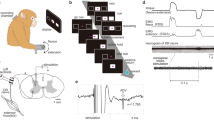Summary
In the preceding report (Alstermark and Sasaki 1986) it was shown that a stimulus of 500 μA applied in the lateral reticular nucleus (LRN) evokes a maximal or near monosynaptic EPSP (LRN EPSP) in forelimb motoneurones. This EPSP which is assumed to be selectively mediated by C3-C4 propriospinal neurones (PNs), was used to estimate the strength of the excitatory projection from C3-C4 PNs. A systematic comparison was made of the size and time course of the maximal LRN EPSP in various species of forelimb α-motoneurones innervating shoulder, elbow, wrist and digit muscles. The LRN EPSP was evoked in all investigated species of forelimb motoneurones. When either the peak amplitude or the underlying area of the LRN EPSP was compared, a three-fold range was found with some tendency for the size to vary in the order of wrist > shoulder ≈ elbow > digit > intrinsic paw motor nuclei. Generally, a positive correlation was found in each motor nucleus between the peak amplitude of the LRN EPSP versus the monosynaptic homonymous group Ia EPSP, input resistance and afterhyperpolarization duration respectively (cf. Alstermark and Sasaki 1986). It is therefore postulated, that the LRN EPSP peak amplitude is correlated with motor unit type. Comparison of the time course of the LRN EPSPs was made by measuring the time-to-peak (T-t-p) and half-width (H-w). The finding in the preceding report that the T-t-p and H-w is longer in slow than in fast motoneurones was confirmed and extended to all the investigated motor nuclei. The hypothesis that both fast slow motoneurones receive projection from a group of fast C3-C4 PNs, while slow motoneurones receive an additional projection from a group with lower conduction velocity, can therefore be applied to all forelimb motor nuclei. In addition, it is proposed that some slow shoulder, wrist and digit motoneurones receive projection from a special subpopulation of C3-C4 PNs with very slow conduction velocity.
Similar content being viewed by others
References
Alstermark B, Lindström S, Lundberg A, Sybirska E (1981a) Integration in descending motor pathways controlling the forelimb in the cat. 8. Ascending projection to the lateral reticular nucleus from C3-C4 propriospinal neurones also projecting to forelimb motoneurones. Exp Brain Res 42: 282–298
Alstermark B, Lundberg A, Norrsell U, Sybirska E (1981b) Integration in descending motor pathways controlling the forelimb in the cat. 9. Differential behavioural defects after spinal cord lesions interrupting defined pathways from higher centres to motoneurones. Exp Brain Res 42: 299–318
Alstermark B, Sasaki S (1981) A quantitative comparison of the excitatory projection from C3-C4 propriospinal neurones to various forelimb motoneurones. Neurosci Lett Suppl 7, S 347
Alstermark B, Sasaki S (1985) Integration in descending motor pathways controlling the forelimb in the cat. 13. Corticospinal effects in shoulder, elbow, wrist and digit motoneurones. Exp Brain Res 59: 353–364
Alstermark B, Sasaki S (1986) Integration in descending motor pathways controlling the forelimb in the cat. 14. Differential projection to fast and slow motoneurones from excitatory C3-C4 propriospinal neurones. Exp Brain Res 63: 530–542
Burke RE, Rymer WZ, Walsh JV Jr (1976) Relative strength of synaptic input from short-latency pathways to motor units of defined type in cat medial gastrocnemius. J Neurophysiol 39: 447–458
Clough FM, Kernell D, Phillips CG (1968) The distribution of monosynaptic excitation from the pyramidal tract and from primary spindle afferents to motoneurones of the baboon's hand and forearm. J Physiol (Lond) 198: 145–166
Collatos TC, Edgerton VR, Smith JL, Botterman BR (1977) Contractile properties and fiber type compositions of flexors and extensors of elbow joint in cat: implications for motor control. J Neurophysiol 40: 1292–1300
Fritz N (1981) Ia-Synergismus an der vorderen Extremität der Katze. Dissertation der Fakultät für Biologie der Ludwig-Maximilians-Universität München, Neuburg an der Donau
Fritz N, Iuert M (1981) Basic principles of Ia-connections in the cat forelimb. Neurosci Lett 7: S 347
Grillner S, Hongo T, Lund S (1970) The vestibulospinal tract. Effects on alpha-motoneurones in the lumbosacral spinal cord in the cat. Exp Brain Res 10: 94–120
Gustafsson B, Pinter MJ (1984) An investigation of threshold properties among cat spinal α-motoneurones. J Physiol (Lond) 356: 453–483
Harrison PJ, Taylor A (1981) Individual excitatory post-synaptic potentials due to muscle spindle Ia afferents in cat triceps surae motoneurones. J Physiol (Lond) 312: 455–470
Illert M, Lundberg A (1978) Collateral connections to the lateral reticular nucleus from cervical propriospinal neurones projecting to forelimb motoneurones in the cat. Neurosci Lett 7: 167–172
Illert M, Lundberg A, Tanaka R (1977) Integration in descending motor pathways controlling the forelimb in the cat. 3. Convergence on propriospinal neurones transmitting disynaptic excitation from the corticospinal tract and other descending tracts. Exp Brain Res 29: 323–346
Illert M, Wiedemann E (1984) Pyramidal actions in identified radial motornuclei of the cat. Pflügers Arch 401: 132–142
Wilson VJ, Yoshida M (1969) Comparison of effects of stimulation of Deiter's nucleus and medial longitudinal fasciculus on neck, forelimb, and hindlimb motoneurones. J Neurophysiol 32: 743–758
Author information
Authors and Affiliations
Additional information
This work was supported by the Swedish Medical Research Council (project no. 94 and 6953)
Rights and permissions
About this article
Cite this article
Alstermark, B., Sasaki, S. Integration in descending motor pathways controlling the forelimb in the cat 15. Comparison of the projection from excitatory C3-C4 propriospinal neurones to different species of forelimb motoneurones. Exp Brain Res 63, 543–556 (1986). https://doi.org/10.1007/BF00237477
Received:
Accepted:
Issue Date:
DOI: https://doi.org/10.1007/BF00237477




